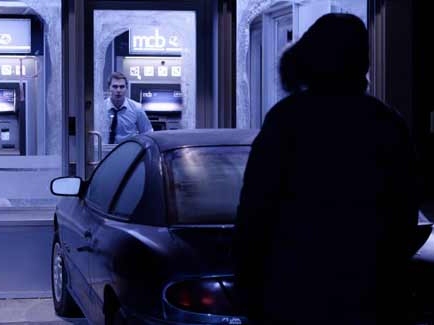There are few more unsettling experiences in life than stopping at a secluded ATM for cash in the middle of the night.
First-time director David Brooks explores that fear in his new movie “ATM” (opening in New York and Los Angeles this weekend and available now via Video On Demand services). The film follows three yuppies who are driving home from a holiday party when they realize they suddenly need cash and are stuck in the middle of nowhere.
They enter the machine’s glass booth, but suddenly a shadowy figure appears in the lot outside – a figure who soon brutally (yet not graphically) kills a dog-walking passerby. It’s clear the trio can’t open the door or risk being killed, but they also left their cell phones in their car. Making matters worse, it’s-5 degrees outside and they have several hours before daylight – and possible help – arrives.
Writer Chris Sparling previously worked claustrophobic magic with the movie “Buried,” in which Ryan Reynolds woke up trapped in a coffin underground in Iraq, and this time he scores again with one creepy moment after another. Yet it’s Brooks who masterfully manipulates the tension in “ATM,” thankfully choosing to shoot most of the violence with taste and restraint (albeit nerve-wracking restraint) rather than using the graphic approach of too many other horror directors.
I spoke with Brooks recently in Los Angeles about “ATM” and his burgeoning career.
BH: What drew you to this subject matter?
BROOKS: One thing that interested me was these people making innocent choices, ones they didn’ t think would lead them down this path. There’s a theme of randomness to it, as it’s not a situation of you do something bad to someone and they do something back. There’s a sense of randomness, asking why certain things happen to people at certain times. And we avoid wrapping everything up in that kind of bow.
BH: Indeed, it’s so random that the characters each have theories on why the killer is after them.
BROOKS: There’s a level of ambiguity people come out with their own kinds of feelings about it. We’re not trying to suggest he’s someone specific.
BH: I was impressed that this wasn’t just a gorefest, but rather you rely on suspense more.
BROOKS: I always thought of it as a thriller more than horror, it was about suspense more than what people associate with horror. We wanted to make the most of gruesome, violent moments and didn’t want it everywhere. If you use it sparingly, it’s more impactful if you build it up. If you’re not crushing people’s heads every moment, you’re wondering when it’s coming next, and that hopefully adds to the tension.
BH: Who are your filmmaking influences?
BROOKS: I’m certainly a big fan of Hitchcock. There weren’t films I looked at specifically , but “Knife in the Water” by Roman Polanski is such an interesting contained, all-on-a-sailboat three character story, very intense. But it’s probably not tonally what I was going for. “Panic Room” and “Dead Calm” also inspired me. I wanted to give the film scope, even though it’s a contained story, not overtly claustrophobic when it doesn’t need to be. I’m a [director] David Fincher fan, the Scott brothers [Tony and Ridley Scott]. Those are the kind of careers with big films that are intense. Not likely to do romantic comedy in all likelihood, but anything else, whether it’s dramas or others, as I like the idea of doing something different everytime like Christopher Nolan.
BH: What was the biggest challenge of making “ATM?”
BROOKS: Finding ways to keep things fresh, and working with the actors and find ways to keep it fresh for them. I was adamant that we shoot in order, 20 days’ worth.
BH: So is there a message that you want to convey with the film?
BROOKS: I think that hopefully there’s room for thematic things, about randomness, and that bad things happen. But ultimately it’s a really fun ride.

COMMENTS
Please let us know if you're having issues with commenting.